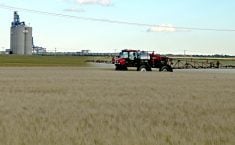Agriculture Canada economists are proposing changes to the way they report farm income forecasts each year.
A senior departmental official in charge of the project said the changes should make the data more useful.
Jan Dyer, director general for research and analysis at Agriculture Canada, said the proposed changes would not alter the basic farm income numbers but would break them down to provide more information on income projections by farm type and farm size.
It also would include revenue from product sales between farms, secondary product sales, custom work revenues and value added income.
Read Also

New coal mine proposal met with old concerns
A smaller version of the previously rejected Grassy Mountain coal mine project in Crowsnest Pass is back on the table, and the Livingstone Landowners Group continues to voice concerns about the environmental risks.
“The existing model that we use for farm income was developed in the 1930s and relies more on averages that don’t reflect the complexities of the modern industry,” Dyer said.
“This will give policy makers, the industry, lenders and input suppliers a better picture of the sector.”
Industry representatives were given an advance look at the proposed changes in late September and there were favourable comments.
“They will be providing more information and more information is good. They will not be changing the basic way the overall numbers are calculated,” said Canadian Federation of Agriculture executive director Justin To.
Dyer said she hopes the new, more detailed reporting plan is put into effect in January or February when the department projects farm income for 2008.
She said income averages can mask different income prospects for different sectors or for different farm sizes or business models.
“I think for lenders or input sellers or policy makers, it will be more useful to know which sectors or models will be doing well and which will not,” she said.
Earlier this year, MPs on the House of Commons agriculture committee received a Library of Parliament report that also questioned the usefulness of reporting farm income averages in an industry as diverse as agriculture.
Yet income reporting does not differentiate between large and small farms or between farmers who intend to make a living from the operation and those for whom the small farm is a sideline, wrote analyst Mathieu Frigon.
It means that policy makers designing farm programs do not have a good handle on what portion of farm payments go to large operators.
“This dichotomy raises the question of what the objectives of an agricultural policy should be,” he wrote. “Responses to this question will be a key factor in deciding whether or not government assistance should be proportionate to farm size.”
Dyer said as MPs were contemplating that question last spring, officials at Agriculture Canada also were considering how the calculation of farm income could be more useful.
However, the exercise does raise a touchy question for the industry.
Is it possible or useful to separate from general income averages those operations that are not considered to be a mainstay profitable family business?
By including anyone who grows food with the intent to sell it in its census of agriculture, Statistics Canada consistently counts as farmers tens of thousands of farm owners with revenues so small they cannot expect net incomes large enough to sustain a family. Still, realized net incomes from those farms are included and drag down the average farm income numbers that policy makers see.
To said it would be useful to have income information based on farm model and business intention, but he warned against making policy based on how large the farm operation is.
“We want to avoid that because smaller farmers can be profitable and they are an important part of the industry.”
He suggested that a distinction between farmers should be based not on size but on investment or an indication of business intention.
However, changes in reporting based on business intentions or realistic expectations of profit will not be part of the changes to be unveiled early next year.
“That is sometime in the future but the debate has started,” To said.
















